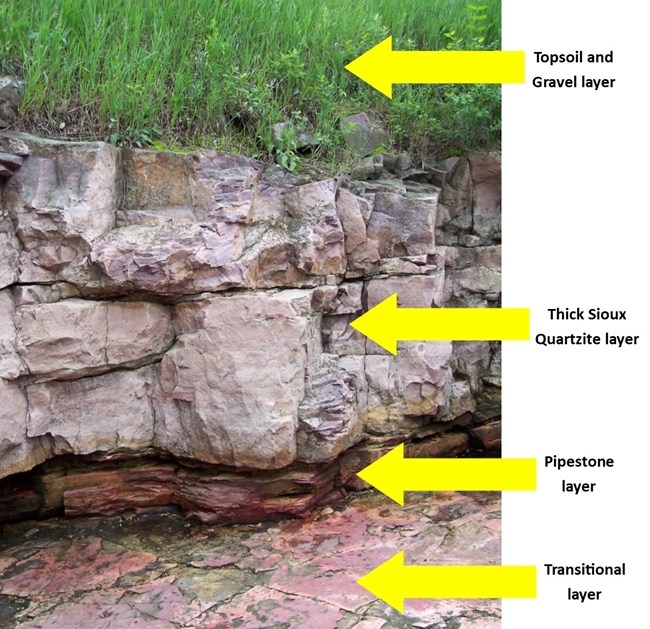
NPS Photo The Monument's geologic formations consist of three rock types: pipestone (clay), quartzite (sand), and conglomerate (gravel). An ancient river deposited thousands of feet of sand throughout the region. Either a flood or settlement deposited clay that was quickly buried under thousands of feet of more sand. Pressue and heat from this deep burial turned the clay and sand into stone roughly 1.6 billion years ago. During the Pleistocene's Ice Ages, the landscape was shaped by glaciers and the conglomerate was deposited on top of the bedrock. What is catlinite? Geologists call the unique variety of pipestone at Pipestone National Monument catlinite, after George Catlin. Although there are other pipestone deposits around the country, they each have a unique chemical signature. Catlinite is only found at Pipestone National Monument. It consists largely of microscopic crystals of pyrophyllite (pie-raw-fill-ite), diaspore (die-ah-spore), muscovite (musk-oh-vite), and kaolinite (kay-oh-lihn-ite). Traces of the iron bearing mineral hematite (heem-ah-tite) give the stone its red color. Most other red pipestones found in the world contain the mineral quartz; catlinite has little or none. Quartzite: How it was made The pipestone layers are sandwiched between much thicker beds of quartzite. Most of the quartzite sand grains are rounded quartz crystals "glued" together by silica (a major component of sand). Heat and pressure from this deep burial and compaction likely dissolved silica at the contact points between sand grains, acting as a cement. The sand became sandstone (which breaks around the sand grains) and then recrystallized into quartzite (so strongly compacted that it breaks across the sand grains). The resulting Sioux Quartzite is harder than ordinary steel (learn more about Pipestone's geodiversity). Pipestone: How it was made Although Sioux Quartzite is extremely hard (7.5 on the Mohs hardness scale), the adjacent layers of pipestone are very soft. The pipestone formed when clay layers were buried between layers of sand thousands of feet thick. Under the same conditions that cemented the sand into quartzite, the fine clay particles lithified into an argillite (claystone) we call pipestone or catlinite. Since the pipestone here at the Monument contains little to no quartz, it is roughly the same hardness as a human fingernail (2.5 on the Mohs hardness scale). It can therefore be easily carved using only the simplest of tools and has made it a dominant source for pipemaking for centuries. Metamorphic or Sedimentary? Although very low grade metamorphism occured, both the Sioux Quartzite and pipestone at Pipestone National Monument are officially classified as sedimentary rock because evidence of minerals that result from the metamorphic processes have not been found here. The seam of pipestone within the Monument slants downward to the east at approximately 8 degrees. The quarries are found along the edge of this seam of rock in a north-south line which is two-thirds of a mile long. Hikers on the 3/4-mile Circle Trail will encounter some of the pipestone quarries in use today along the trail. How do we know Pipestone's rocks are over a billion years old? What is the Mohs hardness scale? Check out the articles below to learn more: |
Last updated: March 30, 2020
